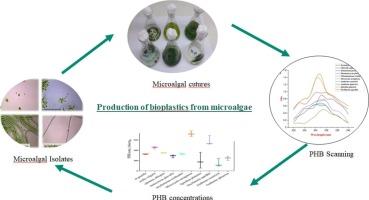埃及微藻中的生物聚合物检测:生态友好型生物塑料之路
Q1 Environmental Science
引用次数: 0
摘要
随着塑料垃圾造成的污染日益严重,必须减少塑料垃圾对环境的危害。因此,用生物塑料取代传统塑料势在必行。生物塑料是一种更加环保的材料,例如由生物资源制成的塑料。绿藻和蓝绿微藻是最近出现的两种最有价值的来源。本研究探讨了利用微藻细胞生产聚羟丁酸、蛋白质和碳水化合物等生物聚合物的可行性。研究采用分光光度标准来量化聚羟丁酸(PHB)和碳水化合物的浓度。此外,还采用凯氏定氮法测定总蛋白质含量。研究了五种绿色微藻菌株和五种蓝绿色微藻菌株。通过测量叶绿素 a 来跟踪生长情况。生长率评估显示,褐藻(Selenastrum gracile)在 15 天时叶绿素 a 浓度最高(6.9 μg/L),蛋白质含量最高(41.13%)。此外,它的 PHB 浓度为 325 毫克/毫升,而碳水化合物含量最低(12 毫克/毫升)。在铜绿微囊藻中检测到的聚羟基丁酸含量最高,为 720.5 μg/mL,蛋白质和碳水化合物含量为 31%(12.3 mg/ml)。硒藻很容易培养,具有进一步研究的潜力。通过与其他聚合物混合,它在生物塑料生产中的应用是未来探索的一个前景广阔的途径。本文章由计算机程序翻译,如有差异,请以英文原文为准。

Biopolymer detection in Egyptian microalgae: A pathway to eco-friendly bioplastics
With the increase in pollution resulting from plastic waste, it was a necessity to reduce the danger of its waste to the environment. Hence, replacing traditional plastic with bioplastic is a must. Bioplastic is more environmentally friendly materials, such as plastic made from biological sources. Green and bluegreen microalgae have recently emerged as two of the most valuable sources. This study examines the viability of using microalgal cells to produce biopolymers, such as polyhydroxybutyrate, proteins, and carbohydrates. The study employed spectrophotometric standards to quantify the concentrations of polyhydroxybutyrate (PHB) and carbohydrates. Additionally, the Kjeldahl method was utilised to determine the total protein content. Five green microalgal strains and five blue green microalgal strains were examined. Chlorophyll a was measured to track growth. Growth rate assessments revealed that Selenastrum gracile exhibited the highest chlorophyll a concentration (6.9 μg/L) at 15 days, accompanied by the highest protein content at 41.13 %. Additionally, it displayed a PHB concentration of 325 mg/mL, while exhibiting the lowest carbohydrate levels (12 mg/ml). Polyhydroxybutrate content maximum concentration was detected in Microcystis aeruginosa 720.5 μg/mL, and 31 % concentration in proteins and carbohydrates (12.3 mg/ml). Selenastrum sp. is easily cultivated and offers potential for further research. Its application in bioplastic production, through blending with other polymers, is a promising avenue for future exploration.
求助全文
通过发布文献求助,成功后即可免费获取论文全文。
去求助
来源期刊

Bioresource Technology Reports
Environmental Science-Environmental Engineering
CiteScore
7.20
自引率
0.00%
发文量
390
审稿时长
28 days
 求助内容:
求助内容: 应助结果提醒方式:
应助结果提醒方式:


